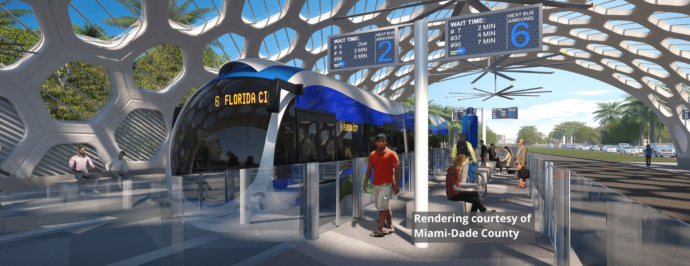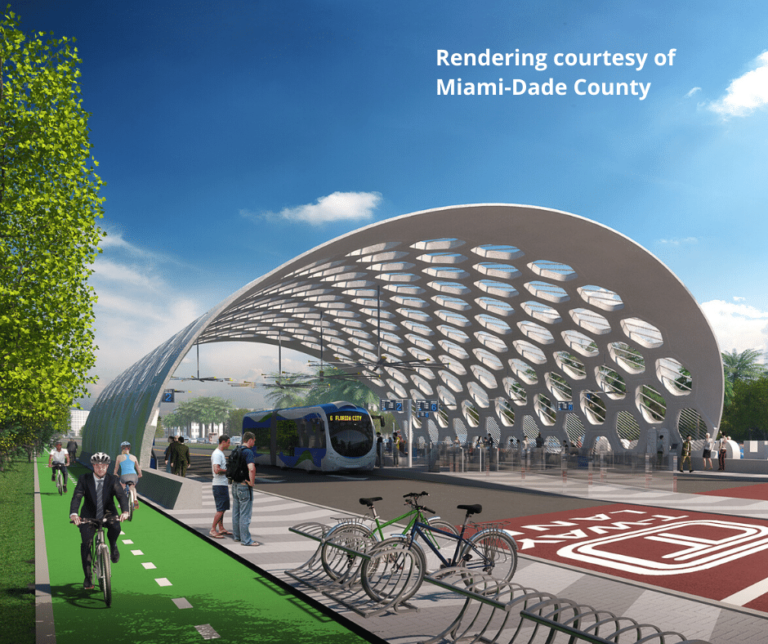
AMERICANS FOR TRANSPORTATION MOBILITY COALITION (ATM)
Written by Debra Zimmerman Murphey
Originally posted in FasterBetterSafer
Part Two of a Two-Part Series
The compelling thing about the United States’ transportation system is that, to some degree, you can examine its history and development on a continuum or a loop.
And often, a look back inspires a step forward.
States such as Florida and regions such as Miami-Dade are not just grappling with planning for, and securing funding for, smarter infrastructure and addressing impacts from climate issues and catastrophic weather events. They are concerned about good systemic infrastructure, nudging close to social marketing by getting more people to use public transportation, and exploring meeting transportation capacity needs through transit long after some cities and suburbia took shape.
“It’s important to note that other major U.S. cities, like New York and Chicago, were planned before the automobile. Miami, Miami-Dade — our city, our county, they were planned after the car already existed. We are in a moment, where the decisions we make today will greatly impact the future of our county: How our children and our children’s children will move around and what kind of access they will have,” notes Aileen Bouclé, Executive Director of the Miami-Dade Transportation Planning Organization (TPO). “The implementation of the SMART [Strategic Miami Area Rapid Transit] Plan’s comprehensive transportation approach will improve existing service and increase our impact to approximately 63 percent of Miami-Dade County’s population — 1.7 million residents live within two miles of the six SMART Plan corridors, and 75 percent of the employment, 855,000, within two miles of the corridors.”
 The SMART Plan was adopted by the Miami-Dade TPO Governing Board in April 2016. It represents a program of projects consisting of six rapid transit corridors and a Bus Express Rapid Transit (BERT) network, which will operate on existing and future express lanes.
The SMART Plan was adopted by the Miami-Dade TPO Governing Board in April 2016. It represents a program of projects consisting of six rapid transit corridors and a Bus Express Rapid Transit (BERT) network, which will operate on existing and future express lanes.
Miami-Dade’s Metrorail was completed in the 1980s with stops such as Coral Gables, downtown Miami, the Civic Center, the Jacksonville Memorial Hospital area, county courthouse, and Hialeah. A spur to the Miami International Airport was finished in 2012.
Massively expanding the area’s sometimes-beleaguered Metrorail is untenable today for financial reasons, and its lack of continued expansion has been controversial as well.
With this in mind, Village of Pinecrest Vice Mayor James McDonald says that the county decided to expand public transportation to Homestead and Florida City via new Bus Rapid Transit (BRT) on an already existing bus lane across the street from the Village of Pinecrest. Its origin extends back to an old Florida East Coast (FEC) Railway line that paralleled U.S. Route 1.
This effort is part of the overarching and forward-looking SMART Plan.
The nearly century-old Route 1, an Interstate Highway which runs from Florida to Maine, and the former FEC (known for the Overseas Railroad to Key West which later provided the foundation for the Overseas Highway) are illustrative of how the nation’s transportation system grew. Train travel, a federal highway program to connect the U.S., and entrepreneurship that ushered in the development of urban centers, disparate geographic pockets and coastlines, established rights-of-way and nascent travel routes that continued to grow.
In the 2000s in Florida, as a case in point, the 95 Express Lane projects were created and funded through an Urban Partnership between the United States Department of Transportation, Florida DOT, local MPOs, local transit agencies and the state of Florida through general funding.¹ They helped reduce congestion and commute times.
These projects point to how federal partners help communities improve infrastructure. “Of course there is a critical federal role for funding infrastructure. There always has been. We need leaders at the national level to recognize this,” notes McDonald. “The states just cannot do all of it.”
In addition to being an attorney, professor and a Councilmember for 12 years, McDonald is Chair of the Miami-Dade County League of Cities (NLC) Transportation Committee, and Chair of the National League of Cities (NLC) Transportation and Infrastructure Services (TIS) federal advocacy committee.
His NLC involvement includes working with NLC members, advocacy and parsing policy issues. They encompass how America is going to: improve its waning infrastructure; create sustainable revenue sources, such as a Vehicle Miles Travelled (VMT) mechanism and increasing the stymied federal gas tax; and guarantee efficacy of the Highway Trust Fund.
Communities Planning for Tomorrow with Public Transit
The American Public Transportation Association (APTA) has identified a need for at least $232 billion in public transportation projects around the nation that could benefit from an infrastructure investment package.
But federal elected officials have not devised a new infrastructure vision and funding legislation.
Regardless, communities are stepping up to do their parts. Houston voters recently overwhelmingly supported a $3.5 billion bond proposal to fund METRO projects to improve public transportation systems and reduce traffic congestion. Maine voters approved a ballot measure that authorizes $105 million in bonds for transportation improvements that include public transit.
 As the Americans for Transportation (ATM) Coalition and its members consistently communicate, ensuring mobility for a range of citizens, workers and businesses will require easing gridlock, modernizing all modes of infrastructure, integrating technology, and moving goods and people in varying ways.
As the Americans for Transportation (ATM) Coalition and its members consistently communicate, ensuring mobility for a range of citizens, workers and businesses will require easing gridlock, modernizing all modes of infrastructure, integrating technology, and moving goods and people in varying ways.
In South Florida, different transit modes, such as rail or rapid bus, may or will be used in differing areas depending on funding sources and what officials determine. Still, the goal is to make sure there is a synergy between the new and evolutionary Bus Rapid Transit (BRT) system, BERT, Metrorail and the overall transportation network. (For instance, the Miami-Dade TPO Governing Board adopted a Locally Preferred Alternative (LPA) for the South Dade TransitWay as BRT and an LPA for the North Corridor as Elevated Heavy Rail.)
“We want to provide options, plenty of options for people to move around. Our residents and visitors should be able to get from point A to point B without having to give too much thought to transportation. Fast and reliable. The future of transportation in Miami-Dade County means more than just bus and rail. It means the seamless integration of all existing modes of transportation and those that are yet to come,” says Bouclé.
Regarding the South Corridor/South Dade TransitWay, McDonald concludes: “People finally understood if we were going to go for Metrorail and expand it, the price tag would have been about a billion and a half. A, there is no money for it currently. B, it would have taken another 10 years maybe — if we’re lucky to get federal funding to do all the engineering and the environmental assessments and the impact studies — and the ridership is [currently] not there for it. … So the county said we are going to do something that is doable, that we can afford and that, if successful and needed, we can always then retrofit it to become Metrorail because the infrastructure, the line, will be there.”
And regarding the national transportation framework and federal legislation, McDonald says: “We have to have a comprehensive view of how we are going to pay for our infrastructure, which is crumbling in most of the country — and not only [for] highways, even locally. I know this from our NLC committee meetings. People from our rural areas talk about their local rural bridges being in disrepair and they don’t have the money for it.”
Nonetheless, public transit is now headed for a revamp in South Florida and likely, over time, throughout the nation. One need not look that far to understand its critical societal roles. Uber, Lyft, Lime, and numerous public transit agencies gave voters a free ride to the polls during the 2018 midterm elections, according to curbed.com.
Read part one of this story.
View original post on FasterBetterSafer
About the Americans for Transportation Mobility Coalition (ATM)
www.fasterbettersafer.org
The Americans for Transportation Mobility (ATM) Coalition formed in 2001. It brings together businesses, the labor and union sectors, transportation stakeholders, and the public to advocate a robust transportation infrastructure grid in the United States. This includes promoting ongoing and sustainable funding through policies and broad-based initiatives.
Tags: Americans for Transportation Mobility Coalition, ATM, ATM Coalition, Debra Zimmerman Murphey, FasterBetterSafer, James McDonald, Miami-Dade County, Miami-Dade County BRT, Smart, Strategic Miami Area Rapid Transit Plan






 RSS Feed
RSS Feed